Multiphysics Modeling, Sensitivity Analysis, and Optical Performance Optimization for Optical Laser Head in Additive Manufacturing
Abstract
:1. Introduction
2. Design, Modeling, and STOP Simulation of an Optical Laser Head for LAAM
2.1. Optical System and Structural Design
2.2. Structural-Thermal-Optical-Performance (STOP) Modeling
2.3. Thermal Effect on Optical Performance with Sensitivity Analysis
- (1)
- the ambient surrounding working condition at the temperature T0 = 293 K;
- (2)
- heat convective coefficientshn = 5 (W/m2K) for all exposed surfaces of the housing andhc = 1500–3500 (W/m2K) for cooling water channel plates;
- (3)
- surface emissivity set at 0.1 at the reflected mirrors due to the copper coating; and
- (4)
- one side of the laser head mounted on the fixed plate via the screws.
3. Optimization with Design of Computer Experiments
4. Conclusions
Author Contributions
Funding
Institutional Review Board Statement
Informed Consent Statement
Data Availability Statement
Conflicts of Interest
References
- Laskin, J.; Faidel, D.; Laskin, V. Optics to control thermal effects in selective laser melting. Laser 3D Manuf. V 2018, 10523, 1052319. [Google Scholar] [CrossRef]
- Louca, R.G.; Yannis, K.; Jean-Pierre, K.; Brecht, V.H. On the influence of thermal lensing during selective laser melting. In Proceedings of the 29th Annual International Solid Freeform Fabrication Symposium, Austin, TX, USA, 13–15 August 2018; pp. 2267–2274. [Google Scholar]
- Huang, Z.; Meng, L.-Q.; Shen, H.; Han, Z.; Zhu, R. Analysis of influence of thermally induced aberrations on laser beam quality factor (M2) in a high-power laser system. Opt. Eng. 2018, 57, 1. [Google Scholar] [CrossRef]
- Thiel, C.; Stubenvoll, M.; Schäfer, B.; Krol, T.A. Reliable beam positioning for metal-based additive manufacturing by means of focal shift reduction. In Macro Processing: Additive Manufacturing; WLT: Munich, Germany, 2015. [Google Scholar]
- Laskin, J.; Laskin, V.V.; Ostrun, A.B. Influence of thermally induced aberrations on resulting intensity distribution. High-Power Laser Mater. Process. Appl. Diagn. Syst. VII 2018, 10525, 1052506. [Google Scholar] [CrossRef]
- Turella, A.; Della Corte, V.; Paolinetti, R.; Palumbo, P.; Amoroso, M.; Castronuovo, M.; Mugnuolo, R. Structural-Thermal-Optical-Performance (STOP) analysis for the prediction of the line-of-sight stability of JANUS camera on board JUICE ESA mission. Opt. Model. Syst. Align. 2019, 11103, 111030E. [Google Scholar] [CrossRef]
- Scola, S.; Stavely, R.; Jackson, T.; Boyer, C.; Osmundsen, J.; Turczynski, C.; Stimson, C. Development and implementation of a generic analysis template for structural-thermal-optical-performance modeling. Opt. Model. Perform. Predict. VIII 2016, 9953, 99530A. [Google Scholar] [CrossRef]
- Gracey, R.; Bartoszyk, A.; Cofie, E.; Comber, B.; Hartig, G.; Howard, J.; Sabatke, D.; Wenzel, G.; Ohl, R. Structural, thermal, and optical performance (STOP) modeling and results for the James Webb Space Telescope integrated science instrument module. Model. Syst. Eng. Project Manag. Astron. VI 2016, 9911, 99111. [Google Scholar] [CrossRef] [Green Version]
- Buleri, C.; Kehoe, M.; Lukashin, C.; Jackson, T.; Beckman, J.; Curtis, A.; Edwards, B.; Owen, T.; Phenis, A.; Stebbins, M. Structural, Thermal, and Optical Performance (STOP) analysis of the NASA ARCSTONE instruments. Photon. Instrum. Eng. VI 2019, 10925, 1092503. [Google Scholar] [CrossRef]
- Bonhoff, T.; Poppe, M.; Stollenwerk, J.; Schleifenbaum, J.H.; Loosen, P. Multi-physical analysis of thermo-optical effects for different Selective Laser Melting (SLM) scanning strategies. Procedia CIRP 2018, 74, 97–101. [Google Scholar] [CrossRef]
- Borror, C.M. Response Surface Methods for Experiments Involving Noise Variables; UMI: New York, NY, USA, 1998. [Google Scholar]
- Gunst, R.F.; Myers, R.H.; Montgomery, D.C. Response Surface Methodology: Process and Product Optimization Using Designed Experiments; John Wiley and Sons: New York, NY, USA, 1995. [Google Scholar]
- Khuri, A.I.; Cornell, J.A. Response Surfaces: Design and Analyses, 2nd ed.; Marcel Dekker: New York, NY, USA, 1996. [Google Scholar]
- Benyounis, K.; Olabi, A.-G. Optimization of different welding processes using statistical and numerical approaches—A reference guide. Adv. Eng. Softw. 2008, 39, 483–496. [Google Scholar] [CrossRef] [Green Version]
- Huehnlein, K.; Tschirpke, K.; Hellmann, R. Optimization of laser cutting processes using design of experiments. Phys. Procedia 2010, 5, 243–252. [Google Scholar] [CrossRef] [Green Version]
- Madrid, J.; Lorin, S.; Söderberg, R.; Hammersberg, P.; Wärmefjord, K.; Lööf, J. A Virtual Design of Experiments Method to Evaluate the Effect of Design and Welding Parameters on Weld Quality in Aerospace Applications. Aerospace 2019, 6, 74. [Google Scholar] [CrossRef] [Green Version]
- Weng, F.; Liu, Y.; Chew, Y.; Yao, X.; Sui, S.; Tan, C.; Ng, F.L.; Bi, G. IN100 Ni-based superalloy fabricated by micro-laser aided additive manufacturing: Correlation of the microstructure and fracture mechanism. Mater. Sci. Eng. A 2020, 788, 139467. [Google Scholar] [CrossRef]
- Liu, Y.; Weng, F.; Bi, G.; Chew, Y.; Liu, S.; Ma, G.; Moon, S.K. Characterization of wear properties of the functionally graded material deposited on cast iron by laser-aided additive manufacturing. Int. J. Adv. Manuf. Technol. 2019, 105, 4097–4105. [Google Scholar] [CrossRef]
- Bi, G.; Gasser, A. Restoration of Nickel-Base Turbine Blade Knife-Edges with Controlled Laser Aided Additive Manufacturing. Phys. Procedia 2011, 12, 402–409. [Google Scholar] [CrossRef]
- Weng, F.; Chew, Y.; Zhu, Z.; Yao, X.; Wang, L.; Ng, F.L.; Liu, S.; Bi, G. Excellent combination of strength and ductility of CoCrNi medium entropy alloy fabricated by laser aided additive manufacturing. Addit. Manuf. 2020, 34, 101202. [Google Scholar] [CrossRef]
- Chen, L.; Yao, X.; Xu, P.; Moon, S.K.; Bi, G. Rapid surface defect identification for additive manufacturing with in-situ point cloud processing and machine learning. Virtual Phys. Prototyp. 2020, 1–18. [Google Scholar] [CrossRef]
- Shi, T.; Lu, B.; Shi, S.; Meng, W.; Fu, G. Laser metal deposition with spatial variable orientation based on hollow-laser beam with internal powder feeding technology. Opt. Laser Technol. 2017, 88, 234–241. [Google Scholar] [CrossRef]
- Paul, C.P.; Mishra, S.; Kumar, A.; Kukreja, L.M. Laser rapid manufacturing on vertical surfaces: Analytical and experimental studies. Surf. Coat. Technol. 2013, 224, 18–28. [Google Scholar] [CrossRef]
- Thompson, S.M.; Bian, L.; Shamsaei, N.; Yadollahi, A. An overview of Direct Laser Deposition for additive manufacturing; Part I: Transport phenomena, modeling and diagnostics. Addit. Manuf. 2015, 8, 36–62. [Google Scholar] [CrossRef]
- Dwivedi, R.; Zekovic, S.; Kovacevic, R. A novel approach to fabricate uni-directional and branching slender structures using laser-based direct metal deposition. Int. J. Mach. Tools Manuf. 2007, 47, 1246–1256. [Google Scholar] [CrossRef]
- Hammeke, A.W. Laser Spray Nozzle and Method. U.S. Patent 4,724,299, 9 February 1988. [Google Scholar]
- Sato, A.; Ishikawa, Y.; Nowotny, S.; Scharek, S. Powder Metal Cladding Nozzle. U.S. Patent 7,626,136, 1 December 2009. [Google Scholar]
- Guo, W. Compact Coaxial Nozzle for Laser Cladding. U.S. Patent 7,259,353, 21 August 2007. [Google Scholar]
- Data and Properties Optics Fused Silica; Heraeus Quarzglas GmbH & Co. KG: Kleinostheim, Germany, 2019.
- Incropera, F.; DeWitt, D. Fundamentals of Heat and Mass Transfer, 2nd ed.; John Wiley: Hoboken, NJ, USA, 1985. [Google Scholar]


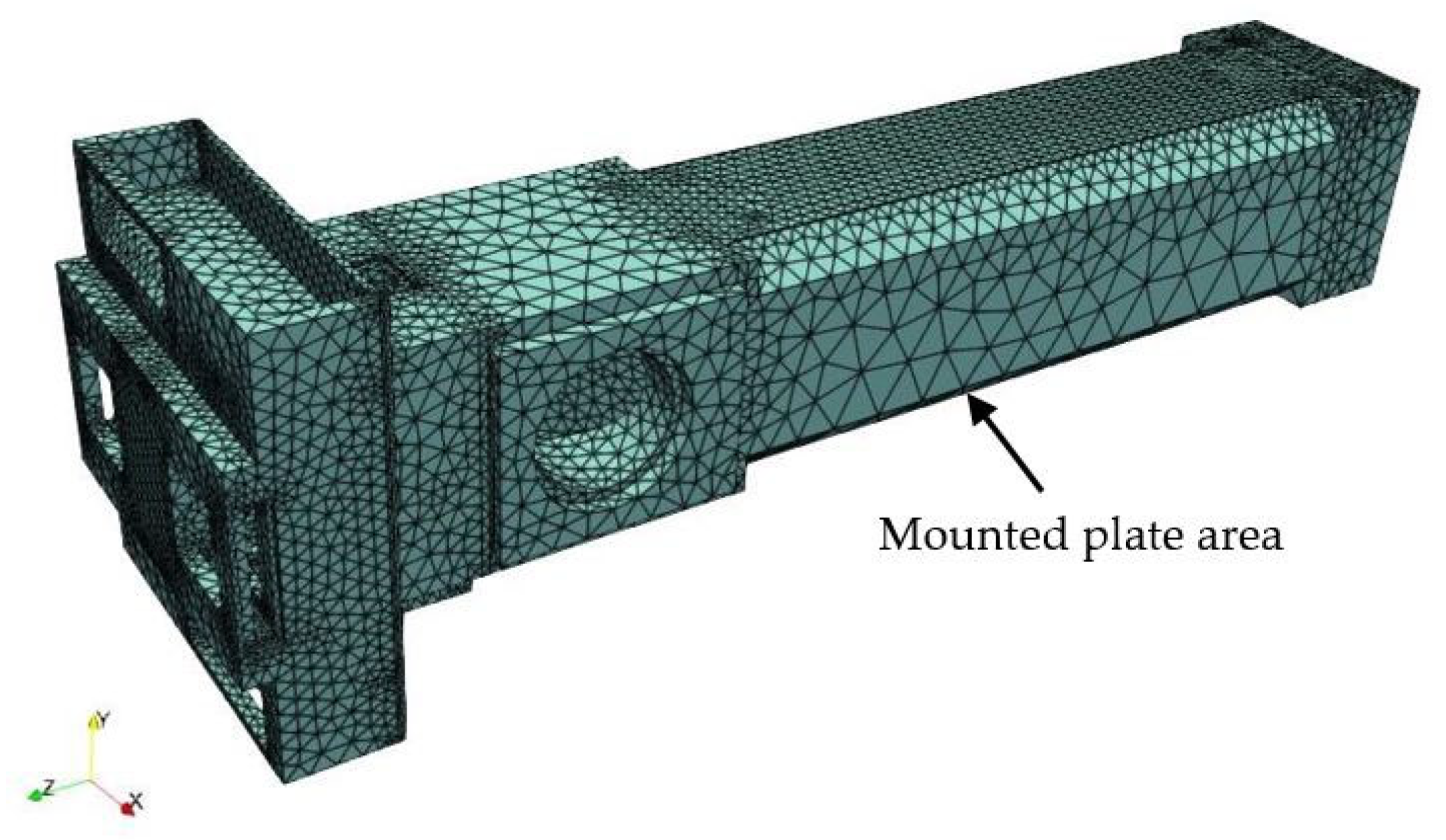
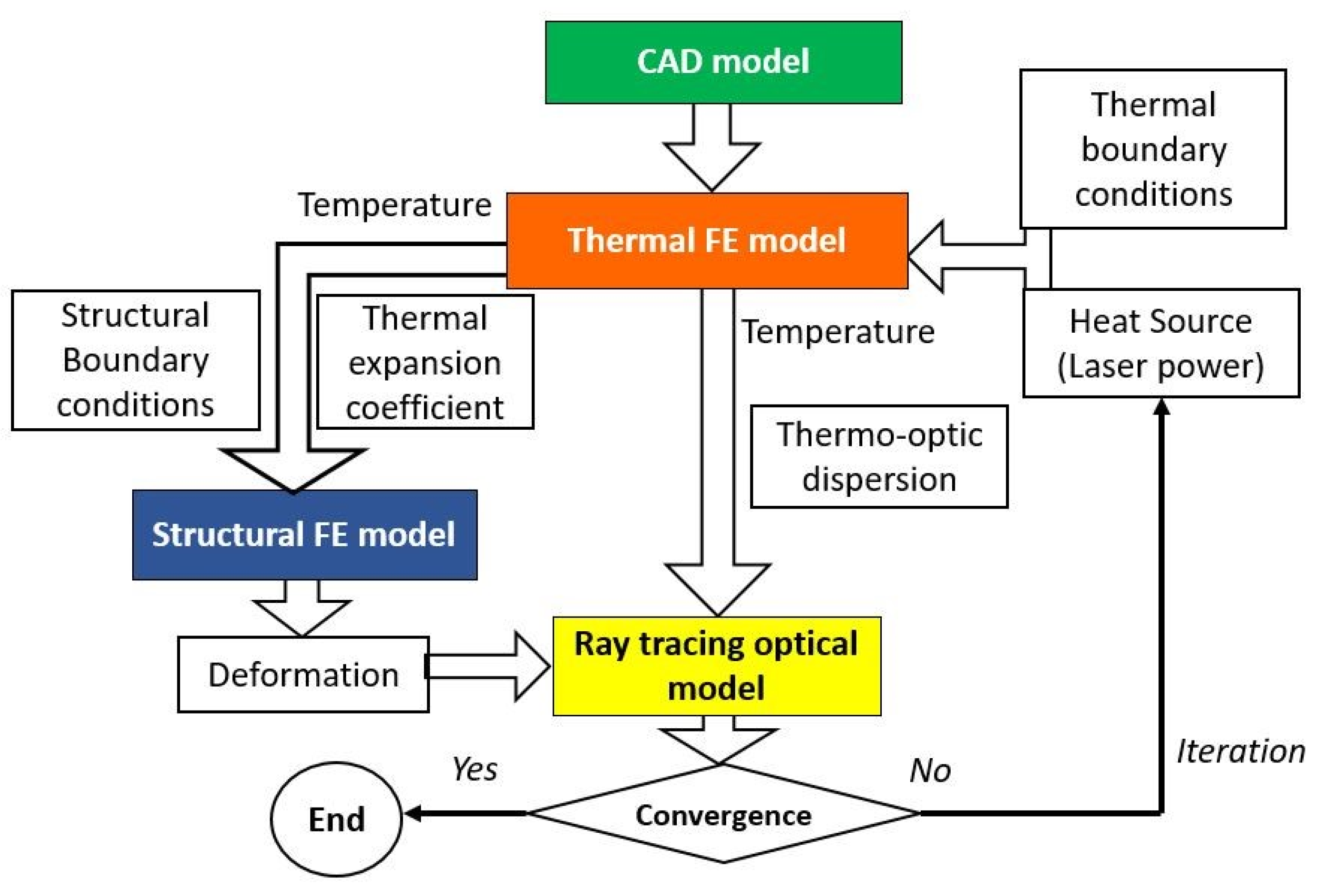

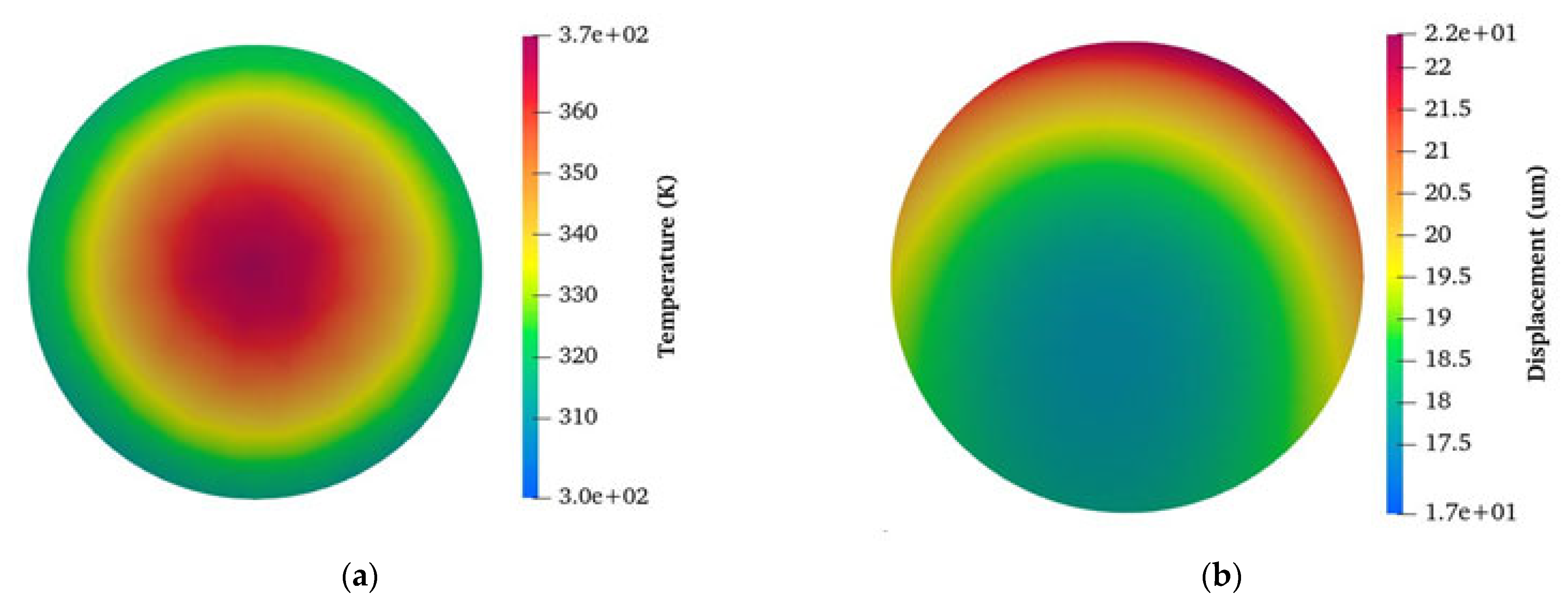
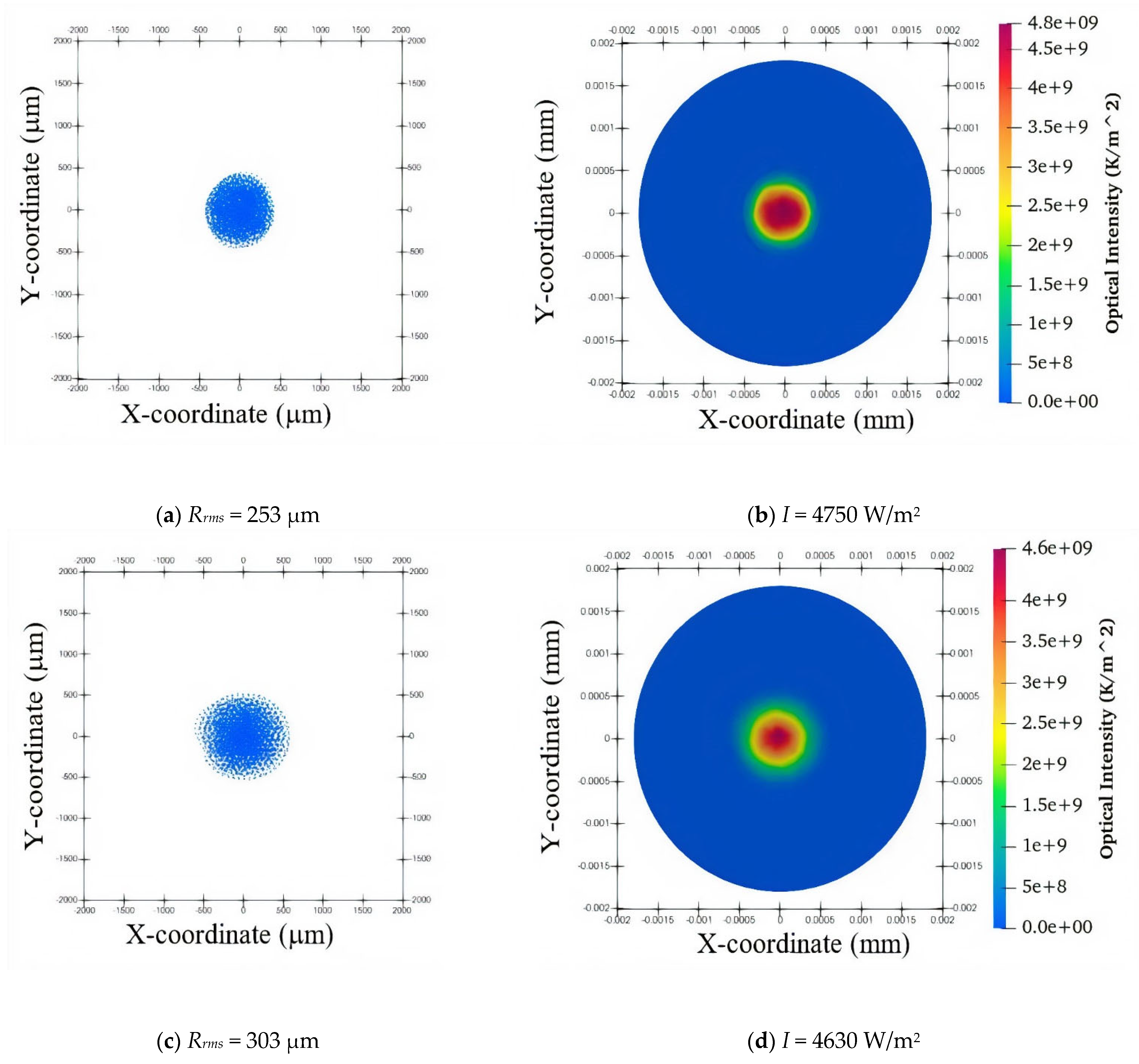




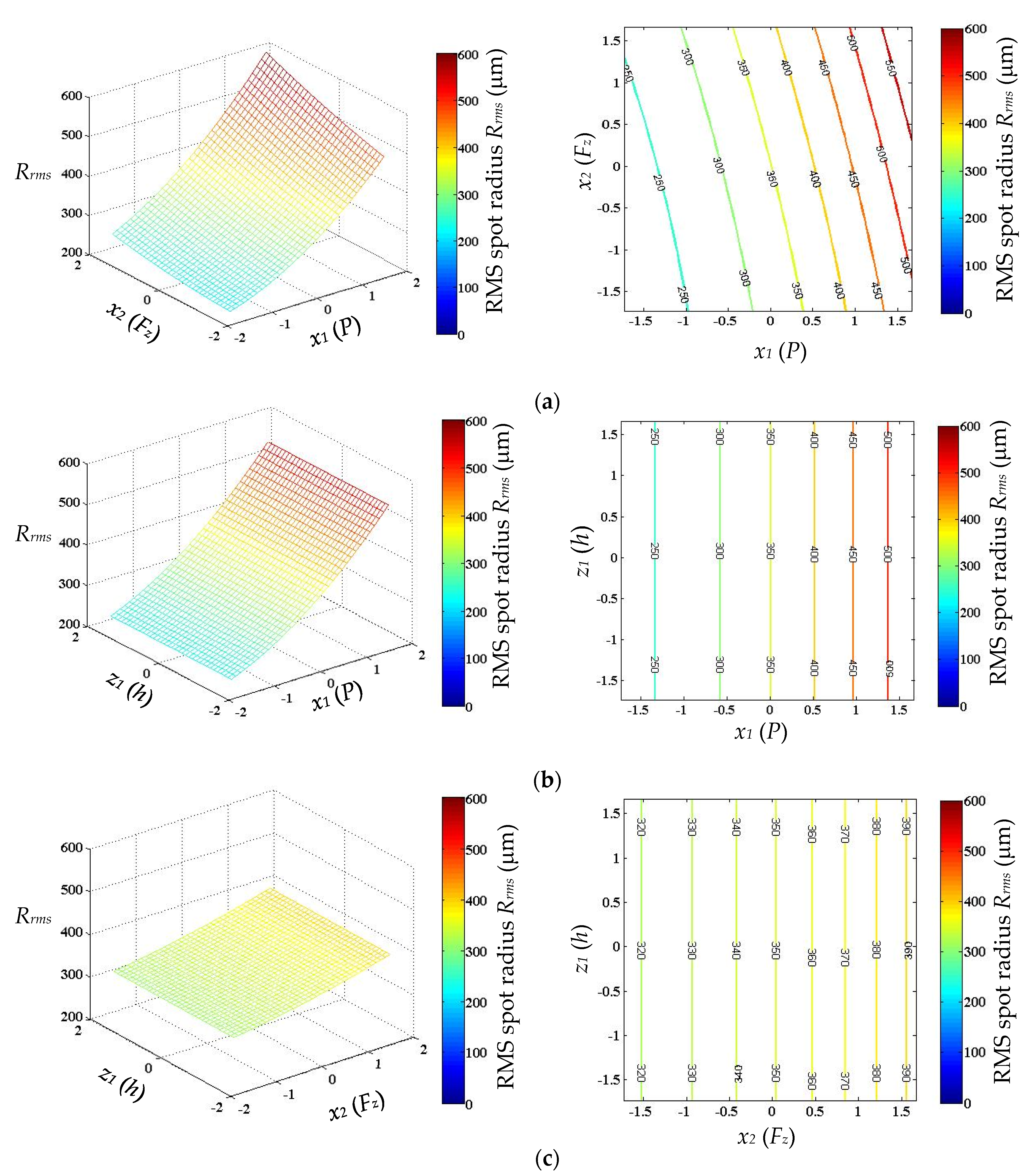
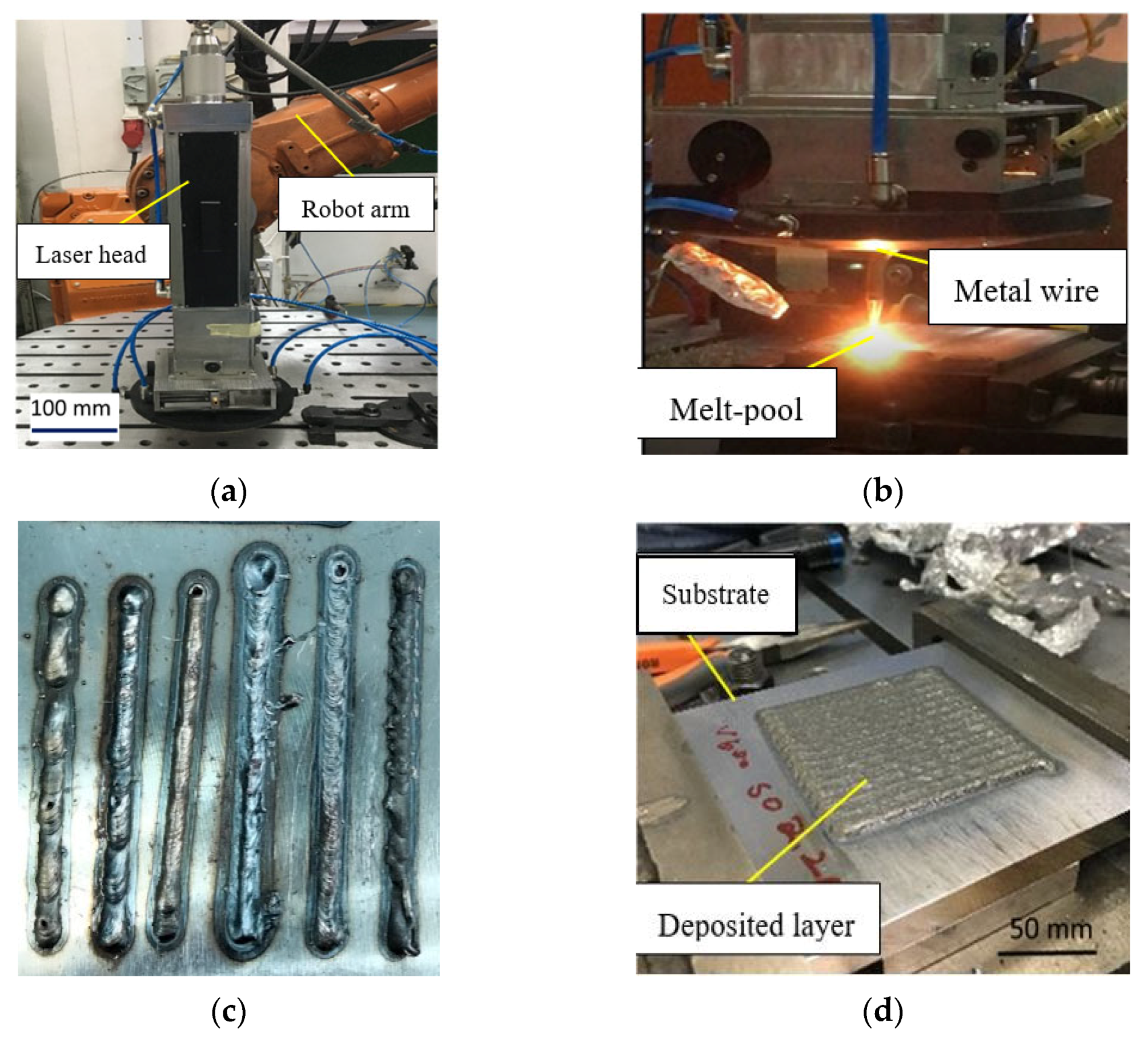
| Material Properties | Fused Silica [29] | Stainless Steel 316 [30] | Copper [30] |
|---|---|---|---|
| Thermal conductivity (W/mK) | 1.38 at 293–375 K 1.47 at 375–475 K 1.55 at 475–575 K 1.67 at 575–675 K | 19 | 401 |
| Heat capacity (J/kgK) | 1.84 at 675–800 K 772 at 293–375 K 964 at 375–775 K 1052 at 775–1175 K | 500 | 384 |
| Thermal expansion coefficient (K−1) | 0.51 × 10−6 at 293–375 K 0.58 × 10−6 at 375–475 K 0.59 × 10−6 at 475–575 K 0.54 × 10−6 at 575–800 K | 18.0 × 10−6 | 17.0 × 10−6 |
| Density (kg/m3) | 2203 | 7990 | 8960 |
| Young’s modulus (Pa) | 73.1 × 109 | 193 × 109 | 120 × 109 |
| Poisson ratio | 0.17 | 0.26 | 0.34 |
| Refractive index | 1.45 − i(T − T0) × 10−5 | ||
| T0 = 293 K |
| Original Level | Coded Level | −1.732 | −1 | 0 | 1 | 1.732 |
|---|---|---|---|---|---|---|
| P (kW) | x1 | 1.00 | 1.634 | 2.50 | 3.364 | 4.00 |
| FZ (μm) | x2 | −173.2 | −100 | 0 | 100 | 173.2 |
| h (W/m2K) | z1 | 1500 | 2500 | 3500 |
| x1 | x2 | z1 | I (W/mm2) | Rrms (μm) | |
|---|---|---|---|---|---|
| 1 | −1 | −1 | −1 | 4750 | 253 |
| 2 | 1 | −1 | −1 | 4540 | 432 |
| 3 | −1 | 1 | −1 | 4740 | 284 |
| 4 | 1 | 1 | −1 | 3320 | 487 |
| 5 | −1 | −1 | 1 | 4740 | 253 |
| 6 | 1 | −1 | 1 | 4130 | 432 |
| 7 | −1 | 1 | 1 | 4770 | 284 |
| 8 | 1 | 1 | 1 | 3420 | 487 |
| 9 | −1.732 | 0 | 0 | 3090 | 239 |
| 10 | 1.732 | 0 | 0 | 3130 | 541 |
| 11 | 0 | −1.732 | 0 | 6310 | 315 |
| 12 | 0 | 1.732 | 0 | 4020 | 399 |
| 13 | 0 | 0 | 0 | 5590 | 351 |
| P (kW) | Fz (mm) | h (W/m2K) | I (STOP) (W/mm2) | I (RSM) (W/mm2) | Rrms (STOP) (μm) | Rrms (RSM) (μm) | |
|---|---|---|---|---|---|---|---|
| Original | 1.634 | −0.1 | 1500 | 4820 | 4875 | 257 | 260 |
| Optimal | 2.28 | −0.173 | 1500 | 6320 | 5813 | 299 | 300 |
Publisher’s Note: MDPI stays neutral with regard to jurisdictional claims in published maps and institutional affiliations. |
© 2021 by the authors. Licensee MDPI, Basel, Switzerland. This article is an open access article distributed under the terms and conditions of the Creative Commons Attribution (CC BY) license (http://creativecommons.org/licenses/by/4.0/).
Share and Cite
Yang, J.; Yao, X.; Cai, Y.; Bi, G. Multiphysics Modeling, Sensitivity Analysis, and Optical Performance Optimization for Optical Laser Head in Additive Manufacturing. Appl. Sci. 2021, 11, 868. https://doi.org/10.3390/app11020868
Yang J, Yao X, Cai Y, Bi G. Multiphysics Modeling, Sensitivity Analysis, and Optical Performance Optimization for Optical Laser Head in Additive Manufacturing. Applied Sciences. 2021; 11(2):868. https://doi.org/10.3390/app11020868
Chicago/Turabian StyleYang, Jiaping, Xiling Yao, Yuxin Cai, and Guijun Bi. 2021. "Multiphysics Modeling, Sensitivity Analysis, and Optical Performance Optimization for Optical Laser Head in Additive Manufacturing" Applied Sciences 11, no. 2: 868. https://doi.org/10.3390/app11020868





